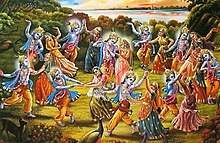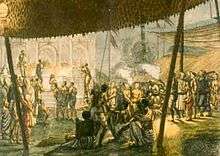Shantipur
| Shantipur Santipur | |
|---|---|
| City | |
 Shantipur Location in West Bengal, India | |
| Coordinates: 23°15′N 88°26′E / 23.25°N 88.43°ECoordinates: 23°15′N 88°26′E / 23.25°N 88.43°E | |
| Country |
|
| State | West Bengal |
| District | Nadia |
| Government | |
| • Type | Municipality |
| • Body | Santipur Municipality |
| • Chairperson | Ajay Dey |
| Area | |
| • Total | 25.88 km2 (9.99 sq mi) |
| Area rank | 1st in Nadia District |
| Elevation | 15 m (49 ft) |
| Population (2011) | |
| • Total | 288,718 |
| • Rank | 2nd in Nadia District |
| • Density | 11,000/km2 (29,000/sq mi) |
| Languages | |
| • Official | Bengali, English |
| Time zone | UTC+5:30 (IST) |
| PIN | 741404 |
| Telephone code | 03472 |
| Lok Sabha constituency | Ranaghat |
| Vidhan Sabha constituency | Santipur |
| Member of Legislative Assembly | Arindam Bhattacharya (politician) |
Shantipur (also known as Santipur) is a city and a municipality in Ranaghat subdivision of Nadia district in the Indian state of West Bengal. This small town has been declared a city recently . The fort area of this city, also known as Daak-Gharh (calling or gathering room) is thought to have been built by Raja Krishnachandra of Nadia. Babla is one of famous place for pilgrims. Rasjatra is a famous festival of Shantipur town.
Geography
Shantipur is located at 23°15′N 88°26′E / 23.25°N 88.43°E.[1] It has an average elevation of 15 metres (49 feet).
Santipur is famous for handloom sarees from ancient times. After the partition of India, many weavers came from Dhaka of Bangladesh and started to reside here in Phulia region, which is a Panchayat area of Santipur.
Demographics
In the 2011 census, Shantipur Urban Agglomeration had a population of 288,718, out of which 147,299 were males and 141,419 were females. The 0–6 years population was 24,006. Effective literacy rate for the 7+ population was 82.67 per cent.[2]
As of 2001 India census,[3] Shantipur had a population of 138,195. Males constitute 51% of the population and females 49%. Shantipur has an average literacy rate of 64%, higher than the national average of 59.5%: male literacy is 69%, and female literacy is 58%. In Shantipur, 12% of the population is under 6 years of age.
Religions
Hinduism is majority religion in Santipur city with 79.15% followers. Islam is second most popular religion in city of Santipur with approximately 20.25% following it. In Santipur city, Christianity is followed by 0.04%, Jainism by 0.01%, Sikhism by 0.02% and Buddhism by 0.01%. Around 0.42% stated Other Religion, approximately 0.11% stated No Particular Religion.
Police station
Shantipur police station has jurisdiction over Shantipur municipality and Santipur CD Block.[5][6] The total area covered by the police station is 111.945 km2 and the population covered is 493,717 (2001 census).[7]
Economy
Since ancient times, Shantipur and the surrounding region has been famous for handloom saris (sah-ree). The handloom weaving style unique to this region are famously known as Santipuri Sari (taat). After the partition of India, Bengal was split into two major regions. West Bengal became a part of India and East Bengal became East Pakistan (Bangladesh). Many skilled weavers from Dhaka, in current day Bangladesh, migrated into West Bengal and settled around the cities of Shantipur and Kalna (Ambika Kalna) of Bardhaman district. Both are traditionally renowned centers for producing hand-woven fabrics sold throughout the country. Through government support for Indian handicrafts and arts, the weaving community slowly grew and thrived. Saris and finely woven feather-touch textiles are still being produced in the same traditional method today. One can find the patterns and colors found in ancient times still reflected in the garments produced in the vast textile belt of Shantipur, Phulia, Samudragarh, Dhatrigram and Ambika Kalna. Each center produces superb fabrics in its own variation of the Shantipuri style of weaving. Shantipur is especially known for super-fine-weave dhotis and jacquards. These textiles are marketed through co-operatives and various commercial undertakings.[8]
Religious History
The old and historical town Shantipur is famous for Ras Utsav and "Dolutsav" which is thought to have begun by Mathuresh Goswami, the great grandson of Advaita Acharya who was one of the main associates of Chaitanya Mahaprabhu.

The principle deity of the town is 'Radharaman' in the family of Baro Gosai descending from the lineage of Mathuresh Goswami. The deity was originally installed as a single statue of krishna named 'dol govinda' in Orissa by king indradyumna. When the king of Yessore (now in Bangladesh), Pratapaditya attacked Orissa, the priest of the temple gave away the deity to his own guru Mathuresh Goswami to protect it in times of emergency. He brought the idol to his ancestral home in Shantipur where he reinstalled it in a new temple. A deity of Radha was later installed beside Dolgovinda and both of them renamed Radharaman.

The deity believed to be worshipped by Advaita Acharya himself is named Madan Gopal and is worshipped in the lineage of Krishna Mishra, the second son of Advaita Acharya.
On the day of Rashyatra, the main festival of the town, all of them are taken out in a grand procession around the city accompanied with drums, kirtan and other celebration. Curiously, all the thrones are lit with the age-old Belgium glass candleholders and chandeliers, instead of electric lighting, even to this day. This gives Rashotsav a very ancient and historical look. On this day, as a continuation of a tradition introduced by Bara Goswamis near about 250 years ago, a young girl, called Rai-Raja (Rai is another name for Radha and Raja means king), dressed in expensive attire and gold ornaments is seated in a throne and paraded across the city to be worshipped as Radha.
Kali Puja is another festival that the people of this place pays a lot of dedication .
There is a unique form of celebrating Kali worship in the form of hand painted image of the deity known as "Pateshwari" meaning drawing of the deity on a piece of cloth. The deity is worshiped for 3 days during the "Rash Utsav." The second day of worship is marked by the sacrifice of a goat. It is then incorporated into the many festive meals and shared with the community until the festival ends.
Notable people
Notable people from Shantipur include: Sir Azizul Haque, Taraknath Gangopadhyay, Karunanidhan Bandhyopadhyaya , Kabi Mohammed Mozammel Haque, Kabi Krittibas Ojha, Arun Chandra Guha and Bijoy Krishna Goswami.
Transport
Shantipur is well connected by rail by EMU railway services running from Sealdah railway station (Main section).
It is also well connected with North and South Bengal by various State Transport Services. National Highway 12 (India) passed through the Santipur town. This is also connected to the district Burdawan (Kalna) and the district Hoogly (Guptipara) through the river Ganges (Bhagirathi).
Private Bus with connected Towns- Ranaghat, Krishnanagar,Habra, Thakurnagar, Gaighata, Kalyani, Chakdah, Beharampur etc.
See also
- Advaita Acharya
- Sir Azizul Haque
- Sudhamoy Pramanick - Indian independence activist
- Diptendu Pramanick - Bengali film personality
- Md.Mozammel Haque
- Arindam Bhattacharya (politician) - Member of Legislative Assembly
References
- ↑ Falling Rain Genomics, Inc - Santipur
- ↑ "Urban Agglomerations/Cities having population 1 lakh and above" (PDF). Provisional Population Totals, Census of India 2011. Retrieved 2011-10-21.
- ↑ "Census of India 2001: Data from the 2001 Census, including cities, villages and towns (Provisional)". Census Commission of India. Archived from the original on 2004-06-16. Retrieved 2008-11-01.
- ↑ "Santipur Religion 2011". Retrieved 23 March 2017.
- ↑ "District Statistical Handbook 2014 Nadia". Table 2.1. Department of Statistics and Programme Implementation, Government of West Bengal. Archived from the original on 29 July 2017. Retrieved 17 May 2017.
- ↑ "Nadia District Police". Police Unit. West Bengal Police. Retrieved 17 May 2017.
- ↑ "Santipur Police Station Details". Nadia Police. Archived from the original on 29 March 2016. Retrieved 17 May 2017.
- ↑ "A Traditional Panorama - Bengal Art". Arts and Crafts in India. India Profile. Retrieved 2007-09-08.